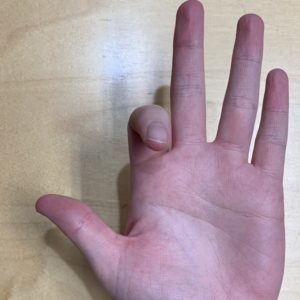The hand and wrist are a very complex part of the body which can be easily injured but very difficult to manage and treat. The hand alone contains 27 bones, 30 separate muscles and three main nerves that supply it. One of the hand injuries that we as Physio’s see is something called ‘stenosing flexor tenosynovitis’, which is commonly known as ‘trigger finger’.
Anatomy
A majority of the muscles that control your hand movements originate from the muscles in the forearm and cross over into the hand as tendons that attach onto specific bony points in the fingers which allow them to move. These tendons are secured to the bone via a number of different sheaths which are known as pulleys. This ensures that the tendons do not become detached from the bone during movement and allow smooth movement between flexion and extension. One of these pulleys is known as the A1 pulley and it attaches at the base of the finger and thumb on the palmar surface.
How does Trigger Finger occur?
Trigger finger can occur when there is a nodule or swelling in the tendon sheath which limits the ability for the finger to extend without clicking or getting caught under the A1 pulley. The extent of the trigger finger can range from being just pain at the base of the finger to catching and locking where the finger can no longer extend. It is unknown why trigger finger occurs; however it is thought to be more prevalent in those who use the affected hand repetitively and those with type 1 diabetes where the lifetime risk of development is 10% compared to the general population where it is 2-3%.1
Signs and Symptoms
The signs and symptoms of trigger finger can range depending on the extent of the injury. These can include:
- Clicking
- Locking
- Localised swelling
- Pain on the palm surface of the finger
Treatment and Management of Trigger Finger
Accurate diagnosis is key when it comes to issues in the hand, fingers and thumbs. There are a few conditions that can masquerade as trigger finger including dupuytren contractures and rheumatoid arthritis. With some finger and thumb conditions, diagnosis needs to be prompt to ensure there is appropriate ongoing management as not all treatments are the same.
For trigger finger treatment can be conservative or non-conservative depending on the amount of catching and the length of time you have had the condition for. Conservative management involves splinting and immobilization of the finger or thumb to help with healing along with help from your GP in terms of medication. When the condition cannot be resolved using these methods, management can include injections or surgery to the affected finger. Your Physio will be best able to guide you for what you need.
If you are experiencing issues with your hand, come in and see one of our experienced Physiotherapists in the Sydney CBD at Bend + Mend.
References:
- Dala-Ali, B. M., Nakhdjevani, A., Lloyd, M. A., & Schreuder, F. B. (2012). The efficacy of steroid injection in the treatment of trigger finger. Clinics in orthopedic surgery, 4(4), 263–268. doi:10.4055/cios.2012.4.4.263






